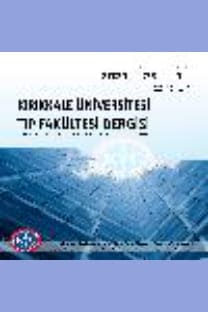STERNUM KAPATILMASI İÇİN POLİETİLEN/POLYESTER KOMPOZİT MATERYALİN BİYOUYUMLULUĞU: DENEYSEL ÇALIŞMA
Polietilen, polyester, sternum, çelik halat, çelik tel, çelik bant, çelik bant
Biocompatibility of Polyethylene/Polyester Composite Material for Sternum Closure: Experimental Study
Polyethylene, polyester, sternum, stainless steel cable, sternal wire, sternal steel band,
___
- 1. Schimmer C, Reents W, Berneder S, Eigel P, Sezer O, Scheld, H et al. Prevention of sternal dehiscence and infection in high-risk patients: a prospective randomized multicenter trial. Ann Thorac Surg. 2008;86:1897-904.
- 2. Olbrecht VA, Barreiro CJ, Bonde PN, Williams JA, Baumgartner WA, Gott VL et al. Clinical outcomes of noninfectious sternal dehiscence after median sternotomy. Ann Thorac Surg. 2006;82:902-7.
- 3. Cheng W, Cameron DE, Warden KE, Fonger JD, Gott VL. Biomechanical study of sternal closure techniques. Ann Thorac Surg. 1993;55:737-40.
- 4. Schimmer C, Sommer SP, Bensch M, Bohrer T, Aleksic I, Leyh R. Sternal closure techniques and postoperative sternal wound complications in elderly patients. Eur J Cardiothorac Surg. 2008;34:132-8.
- 5. Glennie S, Shepherd DE, Jutley RS. Strength of wired sternotomy closures: effect of number of wire twists. Interact Cardiovasc Thorac Surg. 2003;2:3-5.
- 6. Alhalawani AM, Towler MR. A review of sternal closure techniques. J Biomater Appl. 2013;28:483-97.
- 7. Casha AR, Yang L, Kay PH. A biomechanical study of median sternotomy closure techniques. Eur J Cardiothorac Surg. 1999;15:365-9.
- 8. Kalush SL, Bonchek LI. Peristernal closure of median sternotomy using stainless steel bands. Ann Thorac Surg. 1976;21:172-3.
- 9. Bhattacharya S, Sau I, Mohan M, Harazi K, Basu R, Kaul A. Sternal bands for closure of midline sternotomy leads to better wound healing. Asian Cardiovasc Thorac Ann. 2007;15:59-63.
- 10. Orhan SN, Ozyazicioglu MH, Colak A. A biomechanical study of 4 different sternum closure techniques under different deformation modes. Interact Cardiovasc Thorac Surg. 2017;25:750-6.
- 11. Oh YN, Ha KJ, Kim JB, Jung SH, Choo SJ, Chung CH, Lee JW. Multifilament cable wire versus conventional wire for sternal closure in patients undergoing major cardiac surgery. Korean J Thorac Cardiovasc Surg. 2015;48:65.
- 12. Dunne B, Murphy M, Skiba R, Wang X, Ho K, Larbalestier R, Merry C. Sternal cables are not superior to traditional sternal wiring for preventing deep sternal wound infection. Interact Cardiovasc Thorac Surg. 2016;22:594-8.
- 13. Shih CC, Shih CM, Chou KY, Lin SJ, Su YY. Stability of passivated 316L stainless steel oxide films for cardiovascular stents. J Biomed Mater Res A. 2007;80:861-73.
- 14. Grapow MT, Melly LF, Eckstein FS, Reuthebuch OT. A new cable-tie based sternal closure system: description of the device, technique of implantation and first clinical evaluation. J Cardiothorac Surg. 2012;7:59-63.
- 15. Motomatsu Y, Imasaka KI, Tayama E, Tomita Y. Midterm results of sternal band closure in open heart surgery and risk analysis of sternal band removal Artif Organs. 2016;40:153-8.
- 16. http://www.sternaband.com 26.2.18
- 17. http://www.dogsan.com.tr/tr-TR/tektel 26.2.18
- 18. Klink CD, Binnebösel M, Alizai HP, Lambertz A, Junker E, Disselhorst-Klug C et al. Tension of knotted surgical sutures shows tissue specific rapid loss in a rodent model. BMC Surg. 2011;11:36-44.
- 19. Israelsson LA, Millbourn D. Closing midline abdominal incisions. Langenbecks Arch Surg. 2012; 397: 1201-7.
- 20. Idris SB, Dånmark S, Finne-Wistrand A, Arvidson K, Albertsson AC, Bolstad AI et al. Biocompatibility of polyester scaffolds with fibroblasts and osteoblast-like cells for bone tissue engineering. J Bioact Compat Polym. 2010;25:567-83.
- 21. Bélanger MC, Marois Y. Hemocompatibility, biocompatibility, inflammatory and in vivo studies of primary reference materials low‐density polyethylene and polydimethylsiloxane: A review. J Biomed Mater Res A. 2001;58:467-77.
- 22. House HP. Polyethylene in middle ear surgery. AMA Arch Otolaryngol. 1960;71:926-31.
- 23. Terkawi MA, Hamasaki M, Takahashi D, Ota M, Kadoya K, Yutani T et al. Transcriptional profile of human macrophages stimulated by ultra-high molecular weight polyethylene particulate debris of orthopedic implants uncovers a common gene expression signature of rheumatoid arthritis. Acta Biomater. 2018;65:417-25.
- 24. Simonian PT, Simonian TL, Simonian LE. Percutaneous Tension-Band Suture Technique for Distal Patella Fracture Fixation. MOJ Orthop Rheumatol. 2017;8(3):315-18.
- 25. Junge K, Binnebösel M, von Trotha KT, Rosch R, Klinge U, Neumann UP et al. Mesh biocompatibility: Effects of cellular inflammation and tissue remodelling. Langenbecks Arch Surg. 2012;397:255-70.
- ISSN: 2148-9645
- Yayın Aralığı: 3
- Başlangıç: 1999
- Yayıncı: KIRIKKALE ÜNİVERSİTESİ KÜTÜPHANE VE DOKÜMANTASYON BAŞKANLIĞI
STERNUM KAPATILMASI İÇİN POLİETİLEN/POLYESTER KOMPOZİT MATERYALİN BİYOUYUMLULUĞU: DENEYSEL ÇALIŞMA
ERKEK HASTALARIN PROSTAT KANSERİ TARAMALARI HAKKINDA BİLGİ DÜZEYLERİ
ÖZLEM CEYHAN, Songül GÖRİŞ, ABDULLAH DEMİRTAŞ, ZÜLEYHA KILIÇ
SAKRUM’UN MULTİDEDEKTÖR BİLGİSAYARLI TOMOGRAFİ YÖNTEMİ İLE MORFOMETRİK ANALİZİ
Musa ACAR, Şenay Burçin ALKAN, Mehmet Sedat DURMAZ, Erdi SEÇKİN, Kübra ÖZTEMEL, Zeynep SEZGİN, Aleyna AKBABA
İKİ OLGU İLE HEREDİTER ANJİYOÖDEMLİ HASTALARA PREOPERATİF YAKLAŞIMIN GÖZDEN GEÇİRİLMESİ
HÜLYA NAZİK, PERİHAN ÖZTÜRK, MEHMET KAMİL MÜLAYİM, İnci DALYAN
Akut Skrotal Ağrıda Difüzyon Ağırlıklı Manyetik Rezonans Görüntülemenin Rolü
MEHMET BEYAZAL, Hasan Rıza AYDIN, Maksude Esra KADIOĞLU, FATMA BEYAZAL ÇELİKER, Mehmet Fatih İNECİKLİ, Tuğba ELDEŞ, HÜSEYİN EREN
Cam Yumruk Atan Hastaların Demografik, Anatomik ve Klinik Özellikleri
Cama Yumruk Atan Hastaların Demografik, Anatomik ve Klinik Özellikleri
MISIR ŞURUBUNUN METABOLİZMADA OLUŞTURDUĞU ANARŞİ VE HASTALIKLARLA İLİŞKİSİ
